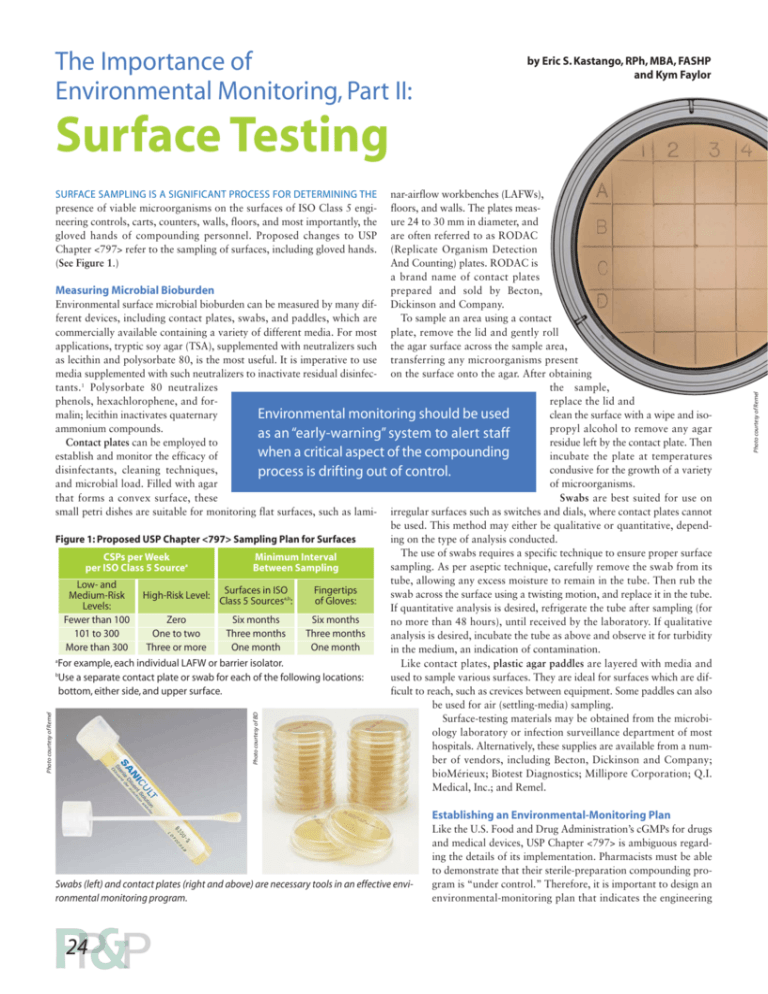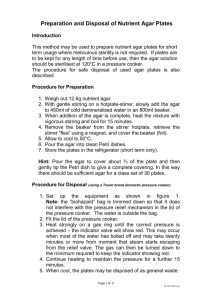
The Importance of
Environmental Monitoring, Part II:
by Eric S. Kastango, RPh, MBA, FASHP
and Kym Faylor
Surface Testing
nar-airflow workbenches (LAFWs),
floors, and walls. The plates measure 24 to 30 mm in diameter, and
are often referred to as RODAC
(Replicate Organism Detection
And Counting) plates. RODAC is
a brand name of contact plates
prepared and sold by Becton,
Measuring Microbial Bioburden
Environmental surface microbial bioburden can be measured by many dif- Dickinson and Company.
To sample an area using a contact
ferent devices, including contact plates, swabs, and paddles, which are
commercially available containing a variety of different media. For most plate, remove the lid and gently roll
applications, tryptic soy agar (TSA), supplemented with neutralizers such the agar surface across the sample area,
as lecithin and polysorbate 80, is the most useful. It is imperative to use transferring any microorganisms present
media supplemented with such neutralizers to inactivate residual disinfec- on the surface onto the agar. After obtaining
the sample,
tants.1 Polysorbate 80 neutralizes
replace the lid and
phenols, hexachlorophene, and forclean the surface with a wipe and isomalin; lecithin inactivates quaternary
Environmental monitoring should be used
propyl alcohol to remove any agar
ammonium compounds.
as an “early-warning” system to alert staff
residue left by the contact plate. Then
Contact plates can be employed to
when a critical aspect of the compounding
incubate the plate at temperatures
establish and monitor the efficacy of
condusive for the growth of a variety
disinfectants, cleaning techniques,
process is drifting out of control.
of microorganisms.
and microbial load. Filled with agar
Swabs are best suited for use on
that forms a convex surface, these
small petri dishes are suitable for monitoring flat surfaces, such as lami- irregular surfaces such as switches and dials, where contact plates cannot
be used. This method may either be qualitative or quantitative, dependFigure 1: Proposed USP Chapter <797> Sampling Plan for Surfaces
ing on the type of analysis conducted.
The use of swabs requires a specific technique to ensure proper surface
CSPs per Week
Minimum Interval
sampling. As per aseptic technique, carefully remove the swab from its
per ISO Class 5 Sourcea
Between Sampling
tube, allowing any excess moisture to remain in the tube. Then rub the
Low- and
Surfaces
in
ISO
Fingertips
swab across the surface using a twisting motion, and replace it in the tube.
Medium-Risk
High-Risk Level: Class 5 Sourcesa,b:
of Gloves:
Levels:
If quantitative analysis is desired, refrigerate the tube after sampling (for
Fewer than 100
Zero
Six months
Six months
no more than 48 hours), until received by the laboratory. If qualitative
101 to 300
One to two
Three months
Three months
analysis is desired, incubate the tube as above and observe it for turbidity
More than 300
Three or more
One month
One month
in the medium, an indication of contamination.
a
For example, each individual LAFW or barrier isolator.
Like contact plates, plastic agar paddles are layered with media and
b
Use a separate contact plate or swab for each of the following locations:
used to sample various surfaces. They are ideal for surfaces which are difbottom, either side, and upper surface.
ficult to reach, such as crevices between equipment. Some paddles can also
be used for air (settling-media) sampling.
Surface-testing materials may be obtained from the microbiology laboratory or infection surveillance department of most
hospitals. Alternatively, these supplies are available from a number of vendors, including Becton, Dickinson and Company;
bioMérieux; Biotest Diagnostics; Millipore Corporation; Q.I.
Medical, Inc.; and Remel.
Photo courtesy of BD
Photo courtesy of Remel
Establishing an Environmental-Monitoring Plan
Swabs (left) and contact plates (right and above) are necessary tools in an effective environmental monitoring program.
24
Like the U.S. Food and Drug Administration’s cGMPs for drugs
and medical devices, USP Chapter <797> is ambiguous regarding the details of its implementation. Pharmacists must be able
to demonstrate that their sterile-preparation compounding program is “under control.” Therefore, it is important to design an
environmental-monitoring plan that indicates the engineering
Photo courtesy of Remel
SURFACE SAMPLING IS A SIGNIFICANT PROCESS FOR DETERMINING THE
presence of viable microorganisms on the surfaces of ISO Class 5 engineering controls, carts, counters, walls, floors, and most importantly, the
gloved hands of compounding personnel. Proposed changes to USP
Chapter <797> refer to the sampling of surfaces, including gloved hands.
(See Figure 1.)
controls, sanitization practices,
process, and employees maintain
an environment with consistently acceptable microbial
levels. An environmentalmonitoring plan should be
capable of detecting, in a
timely manner, an adverse
trend in microbial populations, and facilitate the identification of that trend’s
source(s), such as equipment
failure, sanitization practices,
personnel habits, or training deficiencies, so they may be corrected
before the environment is adversely
affected. If the critical elements of
a robust environmental-monitoring
plan are performed and documented regularly, environmental
control can be easily demonstrated
and monitored.
Significantly reduce medication errors
with automation.
Establishing Alert
and Action Levels
Environmental monitoring should
be used as an “early-warning” system to alert staff when a critical
aspect of the compounding process
is drifting out of control. Any formal environmental-monitoring plan
requires the establishment of alert
and action levels, or the threshold
numbers of viable microorganism
colony-forming units (CFUs) that
indicate a facility’s loss of control.
The absolute CFU value has limited
scientific meaning, but is used to
identify adverse trends and deviations from a known baseline of
microorganisms within a controlled
environment. Acting on trends or
shifts in CFU count can prevent significant problems that could affect
compounded sterile preparation
(CSP) quality. However, it is not
appropriate to use environmental
data (action or alert levels) as CSP
quality release checks, since a direct
cause-effect relationship does not
automatically exist between environmental excursions and product
contamination2. It is also critical to
understand that environmentalbioburden testing, especially testing
Proven pharmacy automation solutions that improve
workflow, medication safety and communication.
Documented reduction in medication errors.
Proven ROI. And better communication and
response times between nursing and pharmacy.
Only McKesson has the proven experience to
automate your central pharmacy regardless of
size, budget or distribution model.
McKesson’s ROBOT-RxTM dispensing system is a
Best in KLAS winner, with more than 300 hospital
pharmacies benefiting from the company’s
second decade of automation expertise.
ROBOT-Rx frees pharmacists from manual tasks
and enables them to impact prescribing patterns
and patient outcomes.
MedCarouselTM reduces picking errors by 96%,
increases picking efficiency by 40%, and allows
technicians to be easily trained in hours instead
of weeks. Coupled with Fulfill-RxSM, which
automates inventory reordering and optimizes
unit-based cabinet inventory, MedCarousel
provides hospitals with a strong ROI.
These solutions are integral parts of the
McKesson Medication Safety AdvantageSM,
a comprehensive solution including software,
automation, bar code packaging, distribution
and consulting that helps reduce medication
errors at every step where they can occur–
from the loading dock to the pharmacy to
the bedside.
For information, call 800-594-9145, or visit
www.mckessonautomation.com/pharmacy.
© 2005 McKesson Corporation. All Rights Reserved.
For more information, circle #56 on the Reader Service Card
25
Visit www.pppmag.com/articles.php to read
The Importance of Environmental Monitoring,
Part 1: Air Sampling.
Figure 3: USP’s Published Levels of CFUs per Contact Plate (24 to 30 cm2)
Figure 2: CFUs and Their Probable Sources
Microorganisms
(via gram stain/
morphology)
Staphylococcus/
Micrococcus
Gram negative rods
Indication
ISO Class
Personnel habits or gowning problems
5
7
8
Equipment
surfaces,
walls etc.
3
5
N/A
Floors
Gloves
Garb
3
10
N/A
3
10
N/A
10
20
N/A
Water condensation, leaking, aerosols
References:
Bacillus species
Molds
Yeast
Diptheroids/
coryneforms
Dust, dirt, floor traffic, possible air handling
Influx of unfiltered air, mold from street clothing
or mold-contaminated carboard, water reservoir,
i.e. incubator humidification system
Possible outdoor air influx; clothing-borne,
especially in late summer/ fall; possible human
contaminant
Poor air conditioning (leading to sweating and
personnel discharge from gowns)
Source: Microbiological Environments
of critical areas like ISO Class 5 workbench surfaces, should not be considered an acceptible substitute for sterility testing. For example, a negative test (absence of CFUs) on a critical surface test does not mean that the
compounded preparation is sterile3.
Data should be collected at evenly distributed intervals for at least one
year to establish a realistic environmental-bioburden baseline. Many variables may affect contamination levels, including seasonal variations in
temperature and humidity. For instance, warmer temperatures and higher
humidity increase operator discomfort and provide better growth conditions for microbes. Outdoor contributors like construction and pollution
can also affect contamination levels, as microbes can be dispersed into the
air and carried into the facility. Another consideration is the facility’s size:
crowding in a small facility may cause operator discomfort and inappropriate cleanroom behavior. In addition, inappropriate cleanroom construction materials, such as non-epoxy-coated gypsum wall board and tile
flooring, can hinder effective cleaning of the controlled environment.
If action levels are exceeded, gram stain morphology can be used to
identify certain microorganisms, and can aid in detecting the source of
contamination and its remediation. (See Figure 2.)
USP Chapter <1116> indicates suggested levels for different air-cleaniliness classifications, but does not indicate if these are alert or action levels. (See Figure 3.) These levels can be used as a resource and initial guide
when establishing alert and action levels. However, actual data from your
facility should be accumulated and analyzed to establish your levels.
Conclusion
Establishing a robust environmental-monitoring plan will provide information on the performance of the facility, including air cleanliness, temperature,
and humidity; compliance of personnel relative to garbing procedures and
movement; effectiveness of cleaning procedures; and aseptic technique and
the handling of components used in the preparation of CSPs. This inexpensive quality metric can yield valuable information and identify issues before
they impact the sterility and integrity of compounded sterile preparations.
26
1. Brummer B. Influence of possible disinfectant transfer on staphylococcus aureus plate counts after agar contact sampling. Appl. Environ.
Microbiol. 1976;32:80-84.
2. PDA Special Scientific Forum on Environmental Monitoring and
Aseptic Processing. PDA Letter. 2000;11:1.
3. Stoedter W. FDA’s Concept Paper on Sterile Drug Products Discussed
at PDA Annual Meeting. PDA Letter. 2003;1:1,7.
Additional Reading:
Block SS, ed. AAMI steam sterilization and sterility assurance in health
care facilities. In Disinfection, Sterilization, and Preservation. 5th ed.
Philadelphia, Pa: Lippincott Williams & Wilkins; 2000:22.
Eric Kastango, RPh, MBA, FASHP, provides expertise in aseptic processing, medical-device manufacturing, and the implementation of extemporaneous compounding-quality systems through his New Jersey-based consulting company, Clinical IQ, LLC. He is also a pharmacy surveyor for
the Accreditation Commission for Health Care, Inc.
Kym Faylor is the manager of quality assurance at Bethlehem,
Pennsylvania-based Microbiological Environments, where she has worked
for the past eight years. She is also a member of the Parenteral Drug
Association, the Biopharmaceutical Education and Training Association, the American Society for Quality, and the Regulatory Affairs
Professionals Society.
Where to find it:
Becton, Dickinson and Company . . . . . . . . . . . . . . . . . . . Circle #92
or visit www.bd.com.
bioMérieux . . . . . . . . . . . . . . . . . . . . . . . . . . . . . . . . . . . . . . . . Circle #10
or visit www.biomerieux.com.
Biotest Diagnostics . . . . . . . . . . . . . . . . . . . . . . . . . . . . . . . . Circle #90
or visit www.biotestusa.com.
Millipore Corporation . . . . . . . . . . . . . . . . . . . . . . . . . . . . . . Circle #12
or visit www.millipore.com.
Q.I. Medical, Inc. . . . . . . . . . . . . . . . . . . . . . . . . . . . . . . . . . . . . Circle #89
or visit www.qimedical.com.
Remel . . . . . . . . . . . . . . . . . . . . . . . . . . . . . . . . . . . . . . . . . . . . . Circle #14
or visit www.remel.com.
Clinical IQ, LLC. . . . . . . . . . . . . . . . . . . . . . . . . . . . . . . . . . . . . . Circle #88
or visit www.clinicaliq.com.
Microbiological Environments . . . . . . . . . . . . . . . . . . . . . . Circle #85
or visit www.microbioenv.com.







